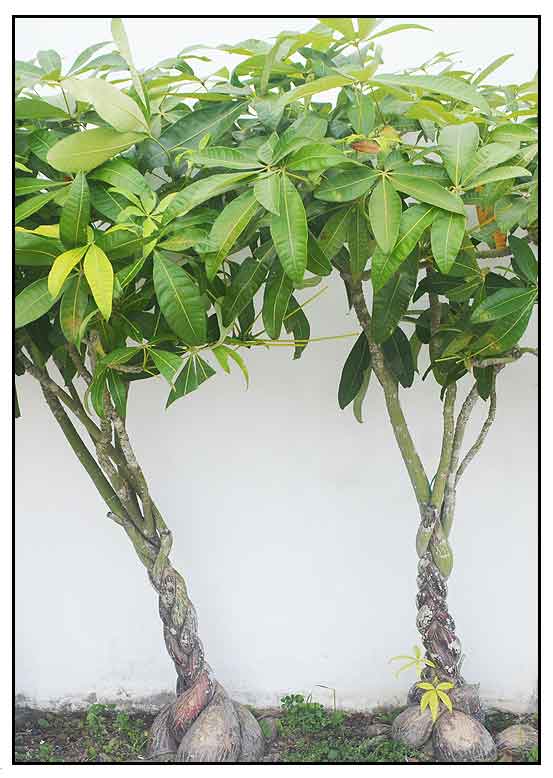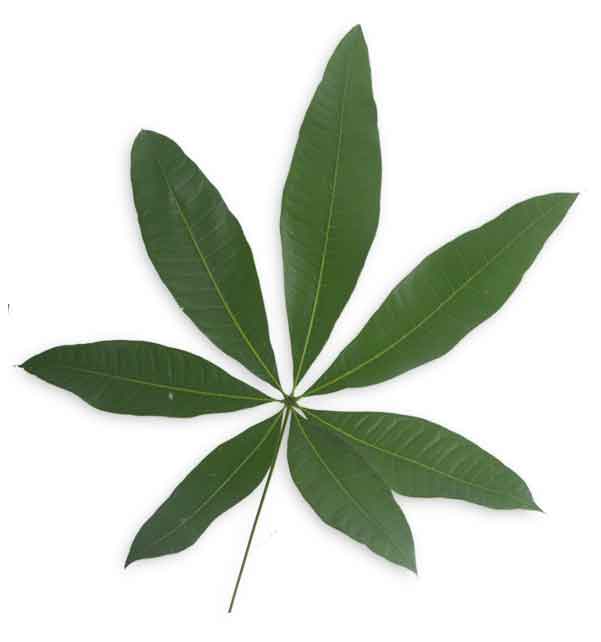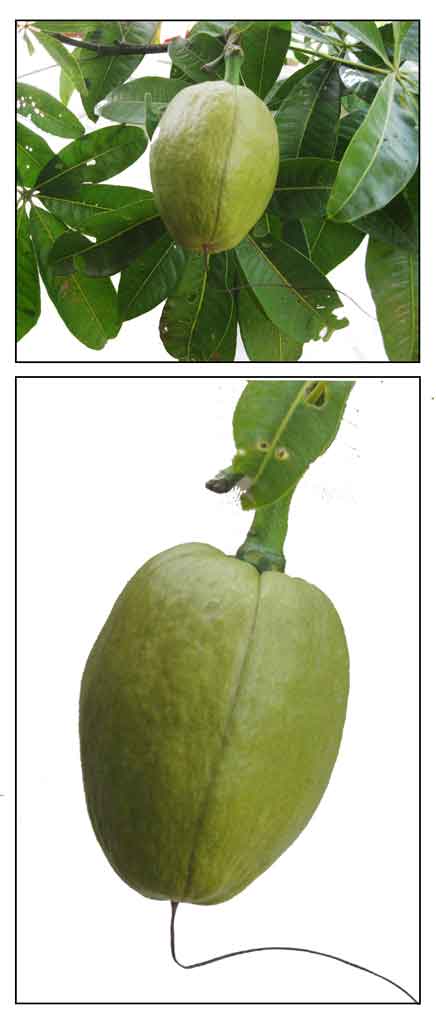 Botany Botany
Pachira aquatics is a small- to medium-sized evergreen tree with dense, round crown, growing to a height of 6-17 meters, occasionally more. Bole is straight and cylindrical, trunk is stout up to 90 centimeters in diameter. Leaves are alternate, palmate compound, with 5 to 11 leaflets.\, 11-15 centimeters long. Flowers are solitary, large, up to 30 centimeters long, with hundreds of reddish or white stamens, style up to 30 centimeters long. Fruit is oblong-ovoid, 14 centimeters long and 9 centimeters wide, with a brown, scurfy hard, tough rind. Seeds are irregularly contained in a large capsule, variable in size, up to 30 centimeters.
Distribution
- Ornamental cultivation: Plants are braided when young and pliable. Once the trunks are braided, they continue to grow that way.
- Cultivated for its edible seeds.
Constituents
- GC-FID and GC-MS studies of hydro distilled essential oil from air-dried leaves of P. aquatics yielded six constituents representing 99.8% of the oil. Major components were 9-octadecenamide (35.1%), photolytic (31.2%), and methyl palmate (19.1%). (6)
 - Study of stems isolated two new naphthalene derivatives, 11-hydroxy-2-O-methylhibiscolactone A (1) and O-dimethylglyoxime S (2), along with 18 known compounds. (see study below) (7) - Study of stems isolated two new naphthalene derivatives, 11-hydroxy-2-O-methylhibiscolactone A (1) and O-dimethylglyoxime S (2), along with 18 known compounds. (see study below) (7)
Properties
- Some conflicting info on toxicity.
Parts used
Leaves and seeds. .
Uses
Edibility
- Seeds, raw or cooked; raw it tastes like peanuts, roasting or frying in oil gives a flavor of chestnuts.
- Seeds can be ground into a flour and used to make bread.
- Seeds sometimes used in the preparation of beverages.
- Young leaves and flowers are cooked, eaten as vegetable.
- (Note: There are conflicting snippets on edibility. While many support edibility, a few warn on the potential toxicity of seed consumption. One mentions cyclopropenoic fatty acid, as possibly toxic and even carcinogenic. Readers are advised to read further on this concern.)
 Folkloric Folkloric
- Skin of immature fruit used for treatment of hepatitis.
- Bark used to treat stomach complaints and headaches. Tisane from boiled bark used as blood tonic. Cold water infusion of crushed leaves used for burning sensation in the skin. (2)
- Bark decoction used to treat anemia, high blood pressure, fatigue and general debility.
Others
- Dye: Yellow or red dye obtained from the bark.
- Fiber/Cordage: Bark yield fiber. Used for making cordage.
(2)
- Oil: Seed oil has potential for making soap. (2)
- Repellent: Fruit spread on the ground to repel fleas. (2)
- Indoor detoxifying plant: Considered an in-door detoxifying plant that removes ethyl benzene and formaldehyde.
Studies
• Composition and Nutritional Properties / Toxicity: Study evaluated three wild plants (Pachira aquatica, Sterculia striata, and Terminalia catappa) for chemical composition and nutritional properties Proximate analysis showed all with high protein content. While deficient in some essential amino acids, P. squatica yielded tryptophan, threonine, and phenylalanine and tyrone contents higher than reported for human milk, chicken egg and cow's milk. Seeds of P. aquatica also exhibited hemagglutinating and trypsin inhibitor activities. The raw seed of P. aquatica was highly toxic when fed to rats at half the meal protein concentration of S. striata or T. catappa. (3)
• Accumulation of Isohemigossypolone in Inner Bark and Heartwood / Fungitoxins: Isohemigossypolone (1) and 2-O-methylisohemigossypolone (2) major fungitoxins of P. aquatica, were found to accumulate locally in the outer bark of the swollen trunk. Study of P. aquatica infected with a phytopathogenic bacterium yielded significant amounts of 1 and 2 from browned inner tissues of the swollen trunk. Findings suggest the inner tissues inducibly produced and accumulated antifungals 1 and 2 during infection events. Study tentatively identified Pseudomonas sp. which promoted tissue browning on sectioned disks. (5)
- Naphthofuranone Derivatives / Superoxide Anion Inhibitory Activity / Stems: Study of stems isolated two new naphthofuranone derivatives, 11-hydroxy-2-O-methylhibiscolactone A (1) and O-methylhibiaxonw S (2), along with 18 known compounds. Of the isolated compounds, compounds 1, isohemigossylic acid lactone-7-methyl ether (4), gmelofuran (6), and 5-hydroxyauranetin (8) exhibited inhibition (IC50 ≤ 28.84 µM) of auperoxide anion generation by human neutrophils in response to fMLP. (7)
Availability
- Ornamental cutivation. |

![]()



 Botany
Botany - Study of stems isolated two new naphthalene derivatives, 11-hydroxy-2-O-methylhibiscolactone A (1) and O-dimethylglyoxime S (2), along with 18 known compounds. (see study below) (7)
- Study of stems isolated two new naphthalene derivatives, 11-hydroxy-2-O-methylhibiscolactone A (1) and O-dimethylglyoxime S (2), along with 18 known compounds. (see study below) (7)  Folkloric
Folkloric